Text
Evolution of Brainy Smurf, Part 5: Quotations of Brainy Smurf

Years covered: 1983-1985.
(Don’t forget to check out my previous posts on this blog if you haven’t!)
Our look into the Brainy of the 80s cartoon series continues! But first, let’s return to the world of the comics for a moment.
In the story Easter Smurfs (from what I can surmise, publication date would be 1983!), we can see Brainy’s egoistic streak rears its head: he contemplates giving Papa Smurf a portrait of himself as a gift for Easter. We also see that scheming, manipulative side usually shown by cartoon Brainy, but in the comics this time: he steals Baker Smurf’s personally-made gift for Papa Smurf to pass it off as his own.

We also see the interior of his home, where we can note books lining the wall, as well as a smurfified version of the phrase “Dura lex, sed lex” (“The law is harsh but it is the law” – yeah, definitely on-theme for comics Brainy!)

Brainy’s characterisation in this comic definitely feels a little different from what it had been before in the comics – a bit more aligned with that of his cartoon counterpart. Seeing as the cartoon show was already well underway by this point, could it be possible that his depiction here was influenced somewhat by his characterisation in the cartoon? An interesting possibility to consider.
But let’s finally get back into the show then, shall we? I’d like to proceed and have a bit of a look at seasons 3-5.
By this point, the basis of Brainy’s distinct 80s cartoon personality is more than established as the know-nothing know-it-all - a bluffing egotist desperate to project an illusion of knowledge who is also prone to indulging in melodrama. He is someone who loves to boss around others, to criticise and critique, to needlessly complicate and bureaucratise… He loves rules, he loves procedures, and he loves enforcing such structures. Continuing these trends, seasons 3-5 are abundant with demonstrations of all of these facets, and more.
In Love Those Smurfs, it’s no coincidence that it’s Vanity, Snappy and Brainy who are the only smurfs not affected by the spell of self-love – naturally, in plots like that, the writers tend to have the unaffected smurfs be the ones who already exhibit given trait(s) that a spell would invoke.
We’re told that Brainy’s very first word was gobbledegook, a perfect encapsulation of… Well. One only has to look at the false diagnoses he loves to throw around:
Brainy: My diagnosis concludes that Baby Smurf has a severe case of grumpirumpititus, aggravated by rumpus moisitosis, aggravated by-
Papa: Brainy! There’s no such thing.
Brainy: Oh. [Laughs sheepishly]

Of course, it’s not all bad. Episodes like Papa’s Family Album and The Dark-Ness Monster certainly show Brainy’s capacity for greater depths.

That said, in these seasons, Brainy really does not hesitate to show off how exceedingly overconfident he is – considering himself a “smurf of all trades”, such as in The Gingerbread Smurfs, assuming himself to have sufficient standing to posit himself as a better baker than Greedy Smurf despite an obvious lack of expertise, to say the least.
Funnily enough, there was one episode that made me go “Huh, Brainy’s characterisation here reminds me a lot more of his comics version, and isn’t (usually) what I’d strictly expect of him in the show…” and what do you know, I then noticed that Peyo himself indeed worked on that episode! I refer to Smurf the Other Cheek and Brainy’s lecture on “the virtue of cleanliness”.
Of course, bossiness and lectures and what have you are nothing new for Brainy, but it’s really the subject matter that made it rather reminiscent of comics Brainy for me. It’s a lecture on virtue, which comics Brainy has really based himself around – cartoon Brainy will lecture others on anything and everything (including virtues, as this very episode demonstrates), however, the “anything and everything” lack of focus makes the sudden lecture on virtue all the more noticeable when it’s coming from cartoon Brainy. And while cartoon Brainy has shown a love of bureaucracy, order, procedure, etc. – all of that is still different from something like cleanliness. A concept like order certainly has its overlaps with cleanliness, but I would argue that you cannot deny they are still two separate, different things. He hasn’t really shown any strong focus on the theme of cleanliness on its own specifically prior to this point. But espousing virtues of all kinds – the theme of virtue – is a very comics Brainy thing.
All this to say: I felt that Peyo’s influence really showed through there! Both comics version and cartoon version already have their subtle influences on one another, perhaps.
One point of clarification: although cartoon Brainy does have a sort of lecturing-on-virtues theme when he, say, chastises Lazy for laziness, Greedy for gluttony, etc – but I would argue that the point of those interactions always seems to be more focused on a theme of bossiness and telling others what to do as opposed to promoting traditional virtues when 80s cartoon Brainy is the one carrying it out. He will just as readily tell Handy how he should build things, how Painter should paint, how Tailor should make clothes – and none of those things have anything to do with virtue.
The virtue/morality/prig theming is, basically, a lot more prominent with comics Brainy.
Another episode I’d like to take a look at is the one in which the smurflings were introduced. In their introductory episode, they burst onto the scene in a challenge of tradition and convention- they buck traditional smurf attire for their own preferences and also challenge other areas of smurf life with novel and unique approaches.
What they bring to the table is fresh and new. They are a force of change.
Of course, this analysis doesn’t have the smurflings as its focus – rather, what the smurfings bring about, what they represent, has been elaborated on here in order to contrast it with our dear, hapless Brainy. More specifically, I would like to highlight how the episode itself contrasts the smurflings’ arrival and their ways with Brainy. He is cast as the traditionalist, all about structure, rules, all about enforcement of the orthodox and of conventional procedures, “old-timey”. Someone who will freely declare “smurflings should be seen and not heard”.
If the smurflings are a force of change, then Brainy, as an opposing force, is one aspiring to an enforcement of a perceived or constructed status quo. Indeed, he gets outright referred to as “old-fashioned” within the episode.
Though smurfs like Tailor balked at the smurflings turning their backs on traditional smurfwear, everyone seems caught up in the thrill of the moment when the smurflings begin performing onstage – that is, everyone except Brainy. The look on everyone’s faces is akin to surprised delight, meanwhile Brainy is more baffled and disapproving. The new musical style confuses him, and he simply can’t abide by it.

Brainy: Papa Smurf, what kind of music is that??
Papa: Er, I don’t think there is a name for it, Brainy.
Clumsy: Oh, gosh, it’s so new, it doesn’t even have a name!
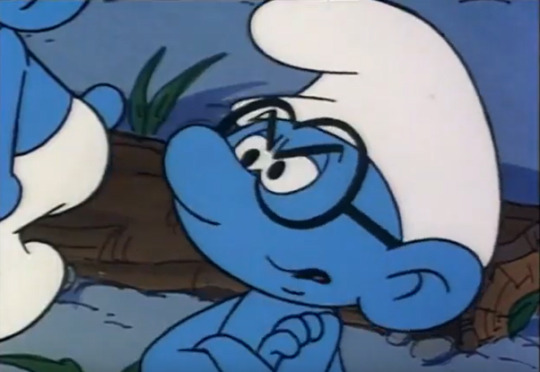
Brainy: I’ll give it a name, it’s phooey.
Papa: Now, now, Brainy, the uh smurflings are merely – aheh – expressing themselves.
And on that cue –

A wave of gasps goes up amongst the crowd that sounds somewhere caught between pleasant surprise (as one can see the smiles remaining on the smurfs in the back of the image) but almost bordering on scandalised as well, as Brainy and Papa’s expressions both turn to shock – Papa himself is momentarily stunned. Yes, as it’s then shown, the smurflings are expressing themselves – in this moment, not just through their music, but also through dance.
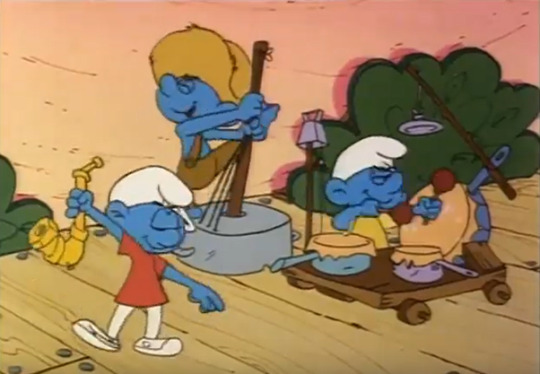

Brainy: Papa Smurf, that is not the dance of the hundred smurfs we’ve all grown to know and love!
Brainy sounds truly affronted – upset. He finds this new style of dancing an insult to what he knows. He is entrenched in the Old Ways, inflexible and not ready to adapt. In contrast, Papa is more welcoming of the change the smurflings bring and represent – speculating that he may be a smurf “ahead of his time”, which is a ready contrast and indication that Brainy is someone rigid and steeped in the past, seeing as Papa has only just been speaking to Brainy who had reiterated his distaste for the smurflings’ music at the episode’s end. He really doesn’t “get” it – it being the new style.
It's testament to the fact that Brainy is truly the resident naysayer, ready to (try and) shoot things down that no smurf else seems to have a problem with, to enforce norms and standards and, in this case, presents a push to “stick to what is known”. This is not to say he always presents with the latter viewpoint – but rather, that this is his role within this episode, and can indicate much about his positioning within the show, and tell us something about his character overall.
Quotations From Brainy Smurf
Finally, I would like to address another point of interest which this post’s title draws upon directly: Brainy’s authoring of his own works. I would also like to comment that the overall title of this post (“Quotations of Brainy Smurf”) is actually something of a misnomer when it comes to a consideration of how these works are actually referred to in-canon; the title of this section (“Quotations from Brainy Smurf”) is actually used with far greater frequency.
As mentioned previously, Brainy writing his own books is a phenomenon that is nowhere to be found within the first two seasons. The third season marks the beginning of references made to “the complete works of Brainy Smurf” (Episode: The Smurfs’ Time Capsule), his memoirs (Episode: Greedy and the Porridge Pot) and, of course, Quotations from Brainy Smurf (Episode: The Golden Smurf Award). (We also get a reference to “Quotations of Brainy Smurf” in A Chip Off The Old Smurf). And for the whole of season 3… that seems to be about it!
Season 4 is more abundant with references to this aspect of Brainy, now that the concept has been introduced by the writing team in the previous season – they pick it up and really run with it! Of course, within the canon of the show itself, we are lead to believe that Brainy has been writing books of his own for most of his life, and that it’s simply an aspect of his character that had not been made salient previously (nor would it have really been present in the minds of the writers prior to its introduction).
It’s not until season 5 that we’re shown Brainy actually branching out into different realms of subject matter beyond mere quotations and journal-ing and memoir-writing. It’s not enough for him to merely write about himself, or to impose his “wit and wisdom” and his quotations onto others: Brainy Smurf will write a book on just about anything, as he is under the unassailable assumption that he is an expert on all things and thus all things are under his purview to be written about. Whether it’s Brainy Smurf’s Secrets to a Successful Future or Games According to Brainy Smurf, he’ll have just the book you’re looking for! Or at least… that’s what he’ll claim, anyway.

Brainy: Mrs Porcupine, when it comes to babies, I wrote the book!
Designated Naysayer
To return to the earlier mentions of naysaying –
Fundamentally, Brainy Smurf fulfilling the role of the naysayer is done alongside being a prolific complainer. He is someone who loves to complain and will typically be written to oppose whatever thing he can be presented as being the most annoying or foolish for opposing in a given scenario. Because that’s the other thing – he is almost always supposed to be the smurf who is In The Wrong – whether that’s playing the role of the fool who falsely believes obvious untruths or the overly skeptical and oblivious fool who can’t notice the obvious, just as an example. It matters not whether he seemingly contradicts himself with his stances at different times (readily and eagerly believing in supernatural phenomena in episodes operating within a framework that suggests such a thing is ridiculous, then refusing to believe in the supernatural in episodes where it makes the most sense to do so) because the only thing of paramount importance (from a writing perspective) in these cases is that he’s usually being an antagonistic against something, whatever that something is.
(And of course, the writers frequently “have their cake and eat it too” by throwing in a nice layer of hypocrisy – when he tries to act like the staunch skeptic, he will often be the first to become afraid by something seemingly supernatural. When he does believe something that turns out to be false, he will claim he knew the truth from the beginning!)
He will support something when it’s counterproductive to do so and oppose something when it is the best solution, because Brainy is someone who is always readily available to act as an antagonistic force on the whim of the writers.
From a diegetic perspective, one can also argue that this is one realm where Brainy’s hypocrisy shines through and that even beyond a Doylist framework, the explanation from a Watsonian point of view is that he is a smurf that likes to be antagonistic “for the sake of it” and enjoys fulfilling this role.
Next time, we will return and see how his character continues to be represented in further seasons of the cartoon show. Thank you so much for reading!!
35 notes
·
View notes
Text

I did up some lists to help illustrate what I discussed in my latest post! I think this lays out some of the compare/contrast nicely.
Also, the point about the mallet gag vs kicked from the village gag isn’t something I really touched on much in my Part 4 post, but I do think it is worth pointing out. It’s especially evident in the ~1976 movie that the other smurfs hitting Brainy with a mallet practically comes second-nature to them; they hardly think about it. It almost comes across as a “tradition” of sorts, where he’s not necessarily being “punished”, it’s more just portrayed as a surefire way to promptly “switch off” his rambling lest it go on continuously unchecked - an automatic response, almost. Meanwhile, in the cartoon, the things Brainy says tend to be a lot more abrasive and such, and so his getting kicked out of the village comes across waaaay more as “deserved” direct retaliation in the way it’s presented to the audience.
There’s arguably some “dark humour” elements attached to the comics treatment - since he’s not necessarily being portrayed as deserving such harsh treatment or such a heavy-handed/harsh response, there’s an element of “disproportionate retribution” attached to it. The humour in the cartoon is more about “annoying guy gets comeuppance”.
(Also, you can say that cartoon Brainy also has a “sense of duty” of sorts, but what I mean by that point is more about the “honour code” that @ schtroumpfcurieux referred to in a reblog. I’m not sure how best to phrase it...)
Oh, and another other thing that I didn’t include in the lists - I would say that Brainy in the cartoon is also far more sarcastic than he is in the comics!
Anyway I guess I’ll type out the above lists contained in the image too, which I’ll put in a readmore!:
Comics (until 80s Cartoon)
More prudent
Sense of duty
More rules-obsessed
More earnest/sincere
More obedient
Aims to project image of moral superiority
More sycophantic(?)
Mallet gag less implied to be “deserved”, treated as more of a knee-jerk “pragmatic” reaction of the other smurfs in response to his rambling
Both
Overly talkative
Annoys the others
Sanctimonious
Always lecturing others
Desire for power and authority over others
Tattletale
Dramatic
Bossy
Usually spouting quotes/sayings
Busybody
Tries to take charge of situations
80s Cartoon
More hypocritical
Reckless
Troublemaker
Known to readily break/bend rules
Dishonest
Manipulative
Cowardly
Scheming
Selfish
Smug
Tries to project an image of being smart.
Papa Smurf’s self-appointed assistant
Gag of being thrown from village portrayed more as being “deserved” and as retribution/retaliation
13 notes
·
View notes
Text
#character evolving in a specific way due to a translation name my beloved#To further back up this:#I grew up with the comics and a very few episodes of the show#so brainy in my mind always fitted more his comic characterization#i remember the whiplash when watching the cartoon after being used to the comics#and seeing brainy act like he does#i have a memory of kid me who really liked brainy being kinda shocked/displeased by it at first#because to kid me brainy still has a sort of honnor code and wanted to do what's best#and in the few episodes i got to see he... wasn't like that
You know, now I’m even thinking that even when trying to “neutrally” analyse comics Brainy, my perception was still far too overshadowed by 80s Brainy, since 80s Brainy is and has always been The definitive Brainy for me.

Maybe this joke here is less about deluded self-obsession to have made this assumption, and more supposed to emphasise his obliviousness and naivety instead.
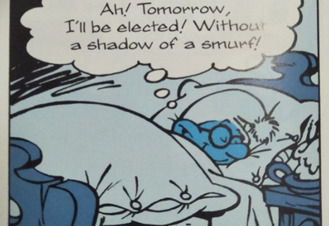
Like, yes, he’s self-deluded here... But maybe less in a self-obsessed way and more in a way where he genuinely thinks he would be a helpful and great leader, with those aspirations, and an assumption that the other smurfs would see that too and elect him.
Even when he’s hypocritically supporting King Smurf after the election, it’s still an act of obedience and being obliging and rule-abiding... Maybe the hypocrisy is supposed to be less emphasised than I assumed and made it out to be. Like, yes, he tries to commit voter fraud (and is too incompetent to pull it off).... I feel like in the comics he had this depiction where he was much more oblivious and earnest. But in the cartoons, he has this scheming and malicious edge to a lot of his behaviour instead... hmm.
But yeah, there does seem to be some level of sincerity/earnestness to comics Brainy, where he does mostly try to actually practice what he preaches, it seems, meanwhile cartoon Brainy.... Well. LOL
Evolution of Brainy Smurf, Part 4: Saturday Morning Cartoon Icon
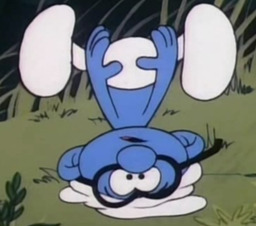
Years covered: 1981-1982
The American Smurfs cartoon of the 80s eclipsed all that had come before in terms of enshrining The Smurfs in popular culture history. It is the most predominant association most people have with smurfs to this day, so I find it hard to overstate the cartoon’s importance and impact.
As we shall look at exploring, the cartoon also had its own definitive take on Brainy Smurf. While Peyo was there behind the scenes and could still exert his influence to some degree, the character had nonetheless now changed hands to be written by Americans in an English-speaking format.
The Smurf universe in its 80s cartoon iteration inevitably broke away somewhat from the French-speaking world of the comics and evolved into something of its own, with a flavour and tone all of its own distinct from what had come before. Peyo’s presence behind the scenes did not stop the Americanisation of the tone of both the world and characters that he had created as the transition between languages and countries, and from comic to TV screen took place.
Up until the 80s, it can be said there was only one singular definitive Brainy Smurf that any depiction either drew upon or deviated from: that of the comics (upon which things like the ~1976 movie directly drew upon, with advertising and other promotional material generally being uncanonical deviations). The 80s cartoon changes this, and a new, distinct Canon of the Brainy Smurf character emerges, making it so there is no longer just one version.
In this post, we will take a look at the first two seasons of the show and take note of the character’s development. What was lost about the character, and what qualities were gained? Etc.
Afficher davantage
36 notes
·
View notes
Text
Evolution of Brainy Smurf, Part 4: Saturday Morning Cartoon Icon

Years covered: 1981-1982
The American Smurfs cartoon of the 80s eclipsed all that had come before in terms of enshrining The Smurfs in popular culture history. It is the most predominant association most people have with smurfs to this day, so I find it hard to overstate the cartoon’s importance and impact.
As we shall look at exploring, the cartoon also had its own definitive take on Brainy Smurf. While Peyo was there behind the scenes and could still exert his influence to some degree, the character had nonetheless now changed hands to be written by Americans in an English-speaking format.
The Smurf universe in its 80s cartoon iteration inevitably broke away somewhat from the French-speaking world of the comics and evolved into something of its own, with a flavour and tone all of its own distinct from what had come before. Peyo’s presence behind the scenes did not stop the Americanisation of the tone of both the world and characters that he had created as the transition between languages and countries, and from comic to TV screen took place.
Up until the 80s, it can be said there was only one singular definitive Brainy Smurf that any depiction either drew upon or deviated from: that of the comics (upon which things like the ~1976 movie directly drew upon, with advertising and other promotional material generally being uncanonical deviations). The 80s cartoon changes this, and a new, distinct Canon of the Brainy Smurf character emerges, making it so there is no longer just one version.
In this post, we will take a look at the first two seasons of the show and take note of the character’s development. What was lost about the character, and what qualities were gained? Etc.
Meet 80s Cartoon Brainy: A Summation of His Characterisation in the First Two Seasons
Brainy Smurf is big on bluffing. He is always insisting that he “knew it all along” or that’s “just what [he] was about to suggest!”. He is regularly clueless but desperate to insist to those around him that no, he totally understands the situation clearly. With a fake-it-till-you-make-it attitude and an unwarranted overconfidence to boot, he’s always ready to put his off-the-cuff assumptions and poorly-informed guesses into action, and it unsurprisingly tends to be a source of all kinds of trouble befalling everyone.
Even when it’s not a matter of him being actively aware of his cluelessness and merely trying to cover it up, he still loves to make a show of his claim to his supposed knowledge at each opportunity he can find. He is always trying to project and impose on others, with rather questionable success, an image of someone that is knowledgeable and knows what he’s talking about… whether or not this is remotely true being another matter entirely.
He is seemingly always ready to exaggerate, downplay or be outright dishonest, whichever tool serves him best when trying to boost his status and/or avoid blame or save face.
Brainy is depicted as cowardly, scheming, manipulative, meddlesome and selfish.
He has a massive ego.
He’s constantly acting like a know-it-all.
He also often acts very dramatic.
Brainy is a smurf who likes to Get Involved with things – and with the organisation of things - in an “official” or authoritative capacity where possible – or, at least, something that is given an outward veneer of being official, whether it’s acting as referee or reading out decrees or calling everyone to attention so that Papa can make an announcement – some sort of role or position distinct from what the others are doing is something he tends to flock to.
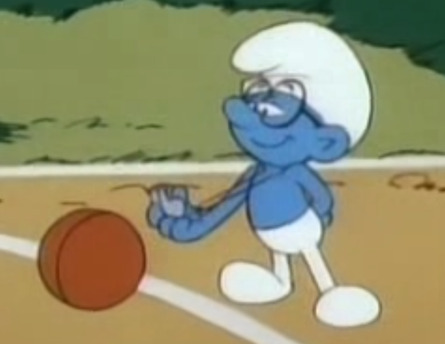

There are many examples of this throughout the first two seasons, one being his involvement as a director in the Robin Smurf play and the role he plays both imparting an introduction at the start and also closing off the play at the end.
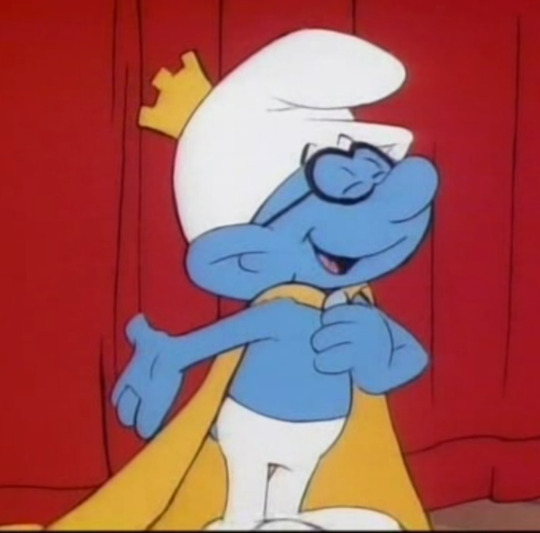
Another example can be found in the episode Clumsy Smurfs the Future. Once the genuine nature of the artifact Clumsy found was established, Brainy immediately tries to take charge despite any of what his previous attitude to the situation had seemed to suggest:
“As Clumsy’s official agent and representative, I have a short list of rules.”
[Unfurls lengthy parchment]
“Official” agent and representative?! Brainy pulled those titles out of absolutely nowhere and this is the very first time he’s trying to make this assertion – his typical bluffing attitude at work. He will throw a bunch of nonsense at you in an attempt to confound you enough to gain some sort of leverage. But this also shows us that he is someone who loves to bureaucratise things (especially as a means of benefitting and conferring some sort of illusory status upon himself).
This love of being Involved with things on some level of perceived importance – and of needlessly creating titles and positions for himself when previously, there were none – can be said to suggest the self-appointed nature of his role as Papa Smurf’s assistant, which has its existence only as a self-appointed role later confirmed. He takes a lot of pride in the assistant role and in many episodes demonstrates a genuine respect and reverence for Papa Smurf as well.
He also arguably shows hints of Purple Prose at times, which goes hand in hand with a theme of needlessly complicating things (see: bureaucratisation), and also fits in nicely with just how overly-talkative he is shown to be in general.
Greedy: Does that look like a winter sky to you, Brainy?
Brainy: Actually, now that you mention it, no! It’s kind of an azure sky with a few high clouds, a bright sun that-
(Episode: S-Shivering S-Smurfs)
Brainy is highlighted as a hypocritical and often unreliable smurf. He is also known to demonstrate a severe lack of self-awareness:
“Clumsy, you talk too much and too loud. Just because Papa Smurf said there was no cure for Lazy, and he was going to smurf off in a few days, is no reason to blab, and furthermore-!”
[Kicked out of the village]
“Leave it to Clumsy to spill the beans…”
-Brainy in Smurf Me No Flowers
Compare & Contrast
Some general notes first: The mallet-to-the-head gag is instead swapped out for Brainy being physically kicked out of the village when he annoys another smurf(s) too much (usually accompanied by some sort of snarky quip!). His habit of condescendingly saying a character’s name thrice when addressing them becomes established. No claim to being Papa Smurf’s assistant had been made in the comics either.
Let’s perhaps first look at some similarities between 80s Cartoon Brainy (hereafter referred to as “Brainy (Smurf)”) and comics Brainy up to the time the 80s show began airing (hereafter referred to as “Schtroumpf à lunettes”).
Both Brainy and Schtroumpf à lunettes are depicted as overly talkative, annoying, and sanctimoniously lecturing/criticising/admonishing other smurfs over their behaviour. They both seem to have a desire for power and authority over others. They’re both tattletales, they can both act rather dramatic at times. They’re both bossy and always spouting quotes/sayings.
But there are differences that are even entwined with the similarities…
Schtroumpf à lunettes trends towards being overly prudent and rule-obsessed; Brainy, in contrast, has a streak of recklessness about him, exacerbating the latter’s hypocrisy when he acts impulsively despite preaching the opposite to others. Both canons incorporate a sense of irony when it comes to the character – like getting so wrapped up in lecturing someone about, say, always being aware of your surroundings that they lose awareness of said surroundings – however, when it comes to Brainy, this irony usually crosses over into the realm of hypocrisy. The irony that gets played with when it comes to Schtroumpf à lunettes is generally portrayed as an unwitting or oblivious contradiction between words and behaviour (for example, sitting on the wrong side of a branch getting sawed off as he lectures a smurf on not doing just that is shown as a foolish, but innocent mistake), meanwhile Brainy will routinely contradict his own relentless lectures in a far more conscious and knowing capacity; there is more blame situationally placed upon the latter – the humour derived instead from the fact that he’s knowingly breaking the rules and standards that he holds everyone around him to, as opposed to a more oblivious or innocent depiction of contradicting his words with his actions in an unwitting way.
Note that Brainy also gets the “oblivious/innocent contradiction” treatment, my point here instead specifically being that Brainy in plenty of other instances is frequently shown to be hypocritical and at fault in ways that Schtroumpf à lunettes had not.
Schtroumpf à lunettes seems to have a greater “sense of duty” (as it is referred to in the 1976 movie) and consistency about him. If we go back to La Soupe Aux Schtroumpfs for a moment – Schtroumpf à lunettes offering himself up to go into the soup seems more born of a desire to be involved and to demonstrate that he is readily obedient and available when Papa Smurf calls upon volunteers. While it is an impulsive action, it’s more depicted as “sense of duty – or at least, superficially demonstrating a sense of duty - to the point of being nonsensical/precluding actual awareness of the realities that a situation would involve” (and also something very very foolish) as opposed to anything approaching hypocrisy and recklessness. I get the impression it’s not really born from recklessness as much as it’s born from plain old obliviousness to the situation – it’s not entirely spur of the moment, after all, seeing as he continues to try and insist that he be allowed to go into the soup even after the others try to deter him.
Arguably, when he is about to give Gargamel instructions to get to the village in the same comic, it is also out of a “sense of duty” – because when someone asks you for something that you can provide, you should - you’re supposed to provide it, right? (Again, it’s impulsive and foolish and unthinkingly done as well, but the “sense of duty” aspect of the character is perhaps more saliently entwined with the intended understanding of it?).

This exact scenario also takes place in the show too, in the episode adaptation of the comic –

“Oh, it’s very simple, just turn left at the Big Oak and follow a little path-”
Ohoh, and one may immediately notice the difference in their expressions as they say this. Schtroumpf à lunettes seems earnest, while Brainy seems keen to impulsively and smugly blurt out the information just to show off. Both are acting unthinkingly in terms of giving Gargamel that kind of knowledge, though seem to be prompted by different motivations.
These different potential readings step into the realm of speculation, but I find it interesting speculation nonetheless that seem to highlight stark differences between the two different iterations of the character.
So, to return to the subject of hypocrisy and consistency… The single biggest demonstration of hypocrisy by Schtroumpf à lunettes had been in the King Smurf comic, committing voter fraud and readily doing a 180 on his words and opinions and such. But apart from that, we just don’t seem to see Schtroumpf à lunettes readily breaking rules and causing trouble in other instances the way that Brainy does - Schtroumpf à lunettes is more readily pigeonholed as too goody-goody for his own good, meanwhile Brainy, while he does try to follow rules, seems to generally think that he’s nonetheless above them and that they’re mainly just for forcing on other smurfs. Schtroumpf à lunettes is the “boring” one that wants to go by the book most of the time – while Brainy will be scheming away at something or other that winds up wreaking havoc on everyone. (Papa just knew Brainy had messed up in The Magnifying Mixture! Did I miss the context for that? Yet his suspicions bulls-eyed on the truth!)
Yes, on a sliding scale of “The Responsible One” to “The Troublemaker”, Schtroumpf à lunettes finds his place closer to “The Responsible One” while Brainy is more akin to “The Troublemaker”.
Both seek to enforce Papa Smurf’s authority and constantly laud Papa’s position, but unlike Schtroumpf à lunettes, Brainy will readily contradict Papa Smurf at times or knowingly go against him. When Schtroumpf à lunettes refuses to stop and listen to Papa Smurf in the Smurfette comic, I’d say it’s meant to be Notable because of how unusual it is. Brainy, meanwhile, may contradict Papa as a matter of course, folding the behaviour into his overarching theme of critiquing others and trying to assert his own suggestions in place:
“Oh, no, Papa Smurf, not fehrite! Quicksilver gives muuuch better results! Further, I believe-“
-Brainy in The Sorcery of Maltrochu
Schtroumpf à lunettes never bluffed anything like Brainy Smurf does constantly. And the wildly selfish streak that Brainy has is just not something Schtroumpf à lunettes had ever really been shown with to this extent. Like, sure, Schtroumpf à lunettes isn’t going to shy away from a little attempted voter fraud in a bid for power, but I can’t really picture him based on what we’ve explored so far spouting off self-centred quotes to this degree, even complete with a devilish laugh at the end:
“I know how to beat this heat – I’ll make a big pitcher of smurfberry juice – and I won’t share it with anybody!”
(Episode: The Magnifying Mixture)
And of course, we have the fact that he is King Smurf in the cartoon-
“I would say thanks if I didn’t deserve every bit of it.”
(Episode: King Smurf)
It’s my opinion these quotes are a bit more out of place for the Schtroumpf à lunettes we have explored so far since so much of his schtick lies in criticising others, not in such overwhelming hypocrisy and egocentrism like this.
Because that’s another thing - EGO. Okay, so, yes, we know Schtroumpf à lunettes was deluded and had a big ego, for sure. But my gosh, I really think Brainy just goes above and beyond anything we’d witnessed from Schtroumpf à lunettes prior to this point.
To explore that further and to better tie together what we have discussed thus far, I think it’s time we talked again about the name change and what identifiable impact it’s had on the character.
The Naming Question
The driving force behind the character’s egoistic attitude undergoes a subtle but important shift from comic to cartoon, where the image the character tries to impress upon others changes thus:
“I know better than you do” -> “I know more than you do”
“I’m better than you” -> “I’m smarter than you”
That is to say, he goes from acting like he’s “a better smurf” to acting like he’s “a more intelligent smurf” than everyone else.
There is a loss of the moralistic/moralising focus of the character. The characterisation of Schtroumpf à lunettes was firmly entrenched in the tradition of the rule-obsessed Prig. Brainy Smurf, meanwhile… yes, he is still priggish, but the priggishness becomes tied up with and muddied with a whole bunch of other additions to the characterisation, and so the sense of superiority that he projects becomes a more generalised sense of superiority bound up in multiple different sources as opposed to a more laser-focus on priggish senses of superiority. Brainy doesn’t just think he’s better than other smurfs in a priggish sense; he thinks he’s better than other smurfs because he has a massive ego entirely independent of that AND he thinks he’s smarter (and therefore thinks he’s better than others for that reason too).
The introduction of the English name “Brainy”, coupled with his glasses, means that Brainy Smurf was no longer a mere prig, but to an English-speaking audience (and writers!) was now ripe to be readily associated with nerd and geek archetypes. His superiority complex now readily calls to mind the trope of the Insufferable Genius (or rather, the Know-Nothing Know-It-All trope).
Throughout the first two seasons, repeated references are made by the character to the concept of braininess/smarts/intelligence as Brainy constantly makes claims that these concepts apply to him. It’s clear that the idea of intelligence is very important to him, something totally absent from the characterisation we have seen of Schtroumpf à lunettes.
“When the only thing smurfs respect is brawn, it’s tough being the brains!”
“Of all the other smurfs, my mind is the sharpest, keenest and most alert.” [immediately collides with Bigmouth]
-Brainy in Supersmurf
Smurfette: There’s only one smurf smart enough to solve this problem and not hurt Clumsy’s feelings.
Brainy: Thank you for the smurfy introduction. I perceive the matter as a conflict of-
Smurfette: I MEANT PAPA SMURF!
(Episode: One Good Smurf Deserves Another)
Schtroumpf à lunettes was never really concerned with being The Smart One or The Intelligent One, he was concerned with being By-The-Book with the rules. Both versions of the character were heavily invested in the idea of being Right About Things, but approaching that goal from different angles/motivations.
All of these references made by Brainy to the concept of intelligence in the show would seemingly be absent were it not for Brainy’s English name. If we imagine for a moment an alternate universe where an 80s smurfs series made with French as the original language with the same budget afforded to the Hanna-Barbera cartoon, featuring Schtroumpf à lunettes, would the same emphasis on this theming be present? Doubtful. We would see a character much more inline with what is presented in the comics, less diluted by further additions to character motivation and self-concept, maintaining an extremely visible priggish theming instead. Now, if we draw upon my previous post and imagine an alternate universe where Brainy’s English name was, say, Morality Smurf instead, we can imagine that the prig theming would likely have been maintained in a far greater capacity, and the character would also be left without reason to make any real mention of the concept of intelligence. And still, we can imagine a Morality Smurf that still heavily resembles the Brainy that we know, just without those references to supposed smarts, replaced with talk of morals instead – a more chaotic and hypocritical Schtroumpf à lunettes, perhaps. (Though even a hypothetical “Morality Smurf” may come to focus too much on talk of morals and not enough on pure pedantic rule-obsession).
If his English name was Tattler Smurf, then naturally it is his tattle-tale behaviour that would get inevitably emphasised and given greater focus in the show. Perhaps in such an alternate universe, the show would have a running theme of “don’t let Tattler Smurf find out”!
If he was Bossy Smurf, he would have his bossiness emphasised, probably with a greater frequency and focus on those typical Brainy scenes where he’s telling others what to do and how to do their jobs, and what have you, and it would tie in well with his bids for power and authority.
You get the picture – as discussed in the last post, regardless of which name was chosen for his English-speaking incarnation, it would cause a shift in focus and framing of the character. And in our case, the character is called Brainy, so the writers, naturally, take note of this and reference the idea of braininess in his dialogue accordingly, thus the character evolves into more of a Know-Nothing-Know-It-All type figure.
Brainy and Books
At the end of this post, I want to take a moment to quickly trace the connection drawn between Brainy and books up until this point.
So you have this one 1973 panel I’ve shown and mentioned in a previous post:

Then there’s the “grammar smurf” he’s carrying around during the events of Smurf Versus Smurf, also brought up by me previously:

Now, once the English name “Brainy Smurf” is bestowed upon him, he’s featured carrying a book of rhymes in the National Benzole commercial:

While this is not a canonical depiction, I nonetheless find it interesting that there was a conscious decision made by the commercial-makers to depict him with a book here.
Now with the advent of the cartoon, a noticeable book theming arises – namely, in one of the key pieces of art for the title cards.

Reading is depicted as one of his pastimes of choice.
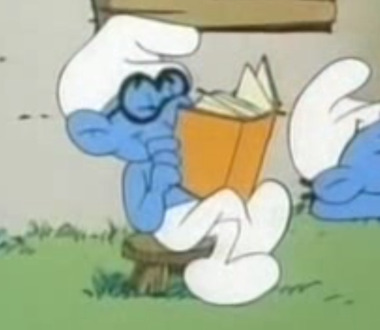
Note that this predates “Quotations of Brainy Smurf”. Brainy writing his own books is not a thing anywhere in the first two seasons.
The English name “Brainy” does seem to be largely to thank for this theming. It’s quite easy to make the leap from geek theming -> book lover. This is definitely an evolution of the character; this connection had never really been present before, e.g. in Smurf Versus Smurf the book he carries around isn’t tied back to a love of reading, it’s tied back to a love of rules and particularities. Again, the characterisation focus seems to have shifted.
So, there we have it – a bit of an overview of the first two seasons and what it introduces for the character and characterisation. Thanks so much for reading – until next time!
#Brainy Smurf#The Smurfs#Smurfs#here we goooooo#I did my best to be comprehensive so I hope I didn't overlook anything much#people can feel free to add stuff on and what have you#Enjoy!!#I really wrote this whole thing up in like 2 days huh. lol#(Obviously watching through the first 2 seasons and taking notes on episodes took A While though :P)
36 notes
·
View notes
Text
The Lost Media Wiki page about the National Benzole commercial can be found here
Evolution of Brainy Smurf, Part 3: What’s In A Name? (Looking Abroad)

Years covered: 1975(?)-1979
Wikipedia lists the original airdate of the movie La Flûte à six schtroumpfs in Belgium as being 7th October 1976. According to the book The World of Smurfs: A Celebration of Tiny Blue Proportions it was released in Belgium (and France and Holland) on Christmas Eve in 1975. Either way, let’s take a look at it! Keep in mind it would still be some three years or so before the movie would be released in English for the first time as “The Smurfs and the Magic Flute”; thus, we must pay mind to its original French incarnation at the moment.
Now, within the movie, we of course have that song that gets sung about how, though the smurfs may be alike in appearance, they each have unique characteristics, and in turn the smurfs get introduced.
In the original French version, the lines in the song referring to Brainy go like this:
“Il a bonne conscience et le sens du devoir, mais le Schtroumpf à Lunettes est un peu bavard.”
Which, courtesy of @schtroumpfcurieux, can be translated as:
“He has a good conscience, and the sense of duty, but Brainy Smurf is a bit talkative.”
Hmm!
Keep reading
32 notes
·
View notes
Text
Evolution of Brainy Smurf, Part 3: What’s In A Name? (Looking Abroad)

Years covered: 1975(?)-1979
Wikipedia lists the original airdate of the movie La Flûte à six schtroumpfs in Belgium as being 7th October 1976. According to the book The World of Smurfs: A Celebration of Tiny Blue Proportions it was released in Belgium (and France and Holland) on Christmas Eve in 1975. Either way, let’s take a look at it! Keep in mind it would still be some three years or so before the movie would be released in English for the first time as “The Smurfs and the Magic Flute”; thus, we must pay mind to its original French incarnation at the moment.
Now, within the movie, we of course have that song that gets sung about how, though the smurfs may be alike in appearance, they each have unique characteristics, and in turn the smurfs get introduced.
In the original French version, the lines in the song referring to Brainy go like this:
"Il a bonne conscience et le sens du devoir, mais le Schtroumpf à Lunettes est un peu bavard."
Which, courtesy of @ schtroumpfcurieux, can be translated as:
"He has a good conscience, and the sense of duty, but Brainy Smurf is a bit talkative."
Hmm!
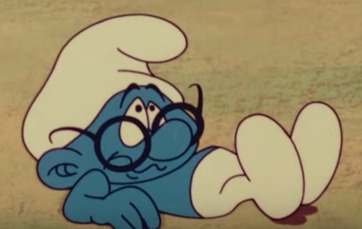
Brainy getting mallet’d is also a thing that is alive and well in this movie. XD
We have mallet gags, we see him lecturing others, and he’s present in other scenes throughout the movie as well. So that’s a wrap on the movie! For now.
Now let’s turn our attention back to the comics for a moment.
1976 also brings us the Smurf Soup comic, La Soupe Aux Schtroumpfs.
In the beginning, Brainy is shown to be cautious and hushes the other since they’re near Gargamel’s hovel. Papa Smurf strategically deploys Brainy to lecture to Bigmouth in order to stall for time. Brainy seems shocked to note that the others are actually seemingly agreeing with him and encouraging his lecturing for once.
Brainy stupidly offers himself up to go into the soup, not realising that the others who have volunteered will be magically protected. Brainy, you FOOL. Not to mention he was also ready to unthinkingly give Gargamel instructions to get to the village, just like that.
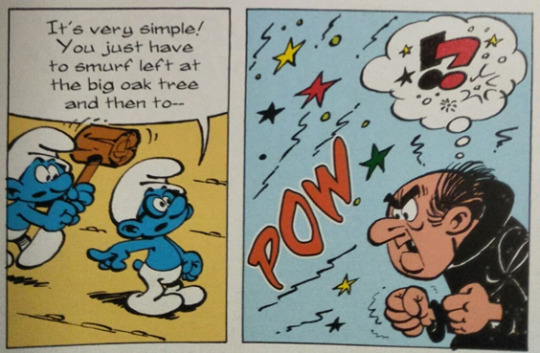
He seems to be very “appearance over content”, unthinkingly prioritising form over substance even to his own detriment or the detriment of others. He doesn’t seem to be thinking through the consequences of his actions beyond the actions themselves. “I must volunteer to go into the soup because Papa requested volunteers, and I must always show myself to be following Papa Smurf’s words, and others are also volunteering…”, not actually thinking through what going into the soup actually entails, and “I know how to get to the village, so I will simply speak those instructions for how to get to the village”, not “it would be bad for myself and the village for Gargamel to have those instructions.”
There is also a collection of one-page comics published the same year;
In the one-page comic “It’s All Fun and Smurfs, Till Someone Gets Smurfed” Brainy is playing chess against another smurf – and loses.
Then there is the comic “Strike The Smurf While It’s Still Smurf” wherein Brainy gets mallet’d by his own reflection! (This comic is incredibly iconic in my eyes, but I may be biased to the extent that I can’t necessarily dissect it in much of the same objective manner that I am usually aiming for in these posts. Its presence on Brainy’s wiki page meant it was one of the first pieces of Brainy content I ever encountered, coupled with the caption seemingly framing the comic as a definitive statement of Brainy’s practically universal ability to annoy – it’s like a suggestion that even he would turn on himself, given the opportunity!)
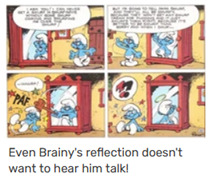
To move on, now- it was The Smurf Song that really pushed the smurfs franchise into the international limelight. It’s interesting to note that Brainy is one of the three smurfs showcased in the associated video for it.

Now, the contents of the songs in the album aren’t canon of course, nor do they really showcase any of Brainy’s personality or anything – he’s just a random placeholder smurf that could have been switched out for anyone. I think his presence is merely to provide some variety since his glasses are something different and unique compared to other smurfs that helps him stand out. It showcases some variety in appearance/design. You have Papa’s presence as a very obvious choice – he’s a prominent character being the smurfs’ leader and with a design that makes him stand out very definitively. You need at least one standard, generic-looking smurf, and then instead of having two smurfs of standard design, they throw in the one with glasses as well, so that all three look different.
And although Smurfette had already been introduced to the franchise at this point, she was not nearly as central to the franchise as she would later become – by this point, she was a character that had been established to not live in the village with the other smurfs, so wasn’t really there/around much at all, plus canon still treated her in a very “othering” way wherein she wasn’t a go-to smurf to think of, but rather something “extra” – arguably a bit of an “afterthought” in the franchise’s eyes, if that makes sense. No Smurfette puppet in The Smurf Song, is what that boils down to. I mean, she wasn’t in Smurfs and the Magic Flute either – because she’s still not an established member of the village at this point. So that rules her out from being centred in any promotional/marketing material (unlike what would become the case later on). We’re left with Brainy as a prominent candidate as “smurf with a slightly different design compared to the others, adding in some variety”. Note that the appearance difference itself is the relevant factor here, not his actual character/personality. He could have had any number of different personalities and would still probably get thrown in for that bit of variety he adds.
The Smurf Song’s English translation was a massive hit in 1978. 1978 also brought us petrol commercials/ad campaigns featuring the smurfs for the English-speaking world. And yeah, Brainy’s featured there too.

Again, not canon and therefore nothing really indicative of Brainy’s character, but it’s interesting to note that in general within popular culture, when a bunch of smurfs are depicted outside of the core canon, there seems to be this notion of “just slap a pair of glasses on one of them” – a general awareness that there is a Glasses-Wearing Smurf that like, Exists, even if nothing at all beyond that is known about the character.
There is something I want to draw attention to however…

Now, Brainy is not referred to by name within these commercials. But the Lost Media Wiki shows this material produced showcasing the contents of one of the commercials before it began airing – it’s internally-produced corporate material.
And he has a name.
In English.
Brainy.
Now, smurf figurines were a Big Deal ever since the 60s… in the European market, at least. It would become a Big Deal in the English-speaking market later on too, but the question is… when? From what I’ve managed to find (and I’m welcome to receive any corrections on this, as well as any comments/feedback/additions on these posts in general!), it took The Smurf Song’s rise to fame first to get smurfs enough of a foothold into English-speaking popular culture before smurfs figurines could become much of a thing in these other parts of the world. We know the smurf figurine craze was booming in English-speaking places in 1978.
And why does this matter, you ask? Well, I’m terribly curious about this for one key reason: Brainy’s English name. If you’re pushing the sale of figurines/merchandise in the English-speaking world and Brainy is featured, the question becomes: how does, say, this smurf with glasses figurine get labelled? Because in the European market, he’d been labelled very straightforwardly as “smurf with glasses”. Or would the merchandise even have an English label to begin with prior to this point? A smurf-with-glasses figurine could still be simply treated as just that, the name cast as something of a point of irrelevance.
So far, the National Benzole commercial is the earliest instance I’ve found where Smurf With Glasses has been given the English name “Brainy”. (Naturally, as an extension of that, any Brainy figurines/merchandise associated with that specific marketing campaign would therefore be labelled with that name too. But still, what about before then…? Were there Brainy figurines available in English-speaking countries? If so, what were they called? Etc.)
We’re left with a couple of possibilities:
· The decision for Smurf-With-Glasses to be called “Brainy” in English had already been made prior to this point, with input from Peyo and co, and the commercial-makers took their cue in his inclusion/naming from this, adopting this name accordingly for their own glasses-clad smurf featured in their commercial
· The name was chosen in the course of making this commercial/associated marketing campaign featuring the Smurfs for the English-speaking places it would be featured in.
And to that end, if the name was only selected in the construction of this marketing campaign, who had the most influence over what the name would be, and what was the thought process behind it? Inquiring minds would love to know…
Either Peyo and co were consulted/had most of the input, or the commercial-makers/marketing campaign runners had most of the input when it came to his name.
In terms of the latter suggestion, keep in mind that these petrol commercials evidently cared very little for actual smurf canon, so it wouldn’t necessarily be too farfetched. They are only using smurfs as advertising set-dressing with no regard beyond that; “National Smurf” is transparently nonsensical in terms of Smurfs canon, created here to exist only for the commercial(s) itself. Smurfs named things like “Cheery” and “Helpful” were never actually established smurfs either – they’re made up by the people who worked on these commercials. I don’t think it’s outside the realm of possibility that the name “Brainy” was chosen somewhat arbitrarily by the people using smurfs to market the sale of petrol, and Peyo and co didn’t really mind/just sort of OK’d it.
Here’s another point of consideration: if Peyo and co did have input into the English name that was chosen, what was their understanding of the English name and the reason it was suitable? How limited were they by the language barrier in place? How much were they needing to rely on an intermediary to bridge the language gap…?
Let’s think about the character’s existence and what we know about him up to this point and the selection of the name “Brainy Smurf”, and let’s play a game where we try to brainstorm hypothetical alternative English names/descriptors for him. I’m certainly not saying it’s easy. And something always tends to get lost in translation – there’s really not much of a way to preserve a 1:1 when you’re switching words between one language to another.
There are a lot of different factors you have to take into account here – you need a name that “works” in English. That takes “Glasses Smurf” or “Smurf-With-Glasses” off the table right away, because those names sound very clunky in English and don’t have much of a ring to them at all. Or to be more specific, “Glasses Smurf” can have its own charm as a name, but doesn’t really adhere to the -y/-er ending convention they’re going for. Not to mention that part of the appeal of smurfs in the smurfs franchise which was further pushed into prominence for the English-speaking world are their different personalities shining through – so when choosing a name in English, you’d preferably want to try for something that says something about the character as opposed to just a straightforward physical description. Not only that, but you want to choose something that works for children to be able to readily comprehend and understand – that rules out words that are too advanced for a standard child’s vocabulary or too complex. Words/names that are too complex also get ruled out if they’re too much of a mouthful to say.
Another point of consideration is marketing. From a money-making point of view, it’s preferable to have characters with marketable names that can become recognisable and appeal to consumers. (Looking somewhat ahead to the English translations of the movie/the 80s TV series, words that are too much of a mouthful to say also get ruled out from a standpoint of the name needing to get regularly used by the characters, and also if the name is too complex not only would it be difficult to say on the regular, but it would likely strain immersion/believability/suspension-of-disbelief on behalf of consumers, unless an over-the-top name is specifically the joke/part of the point).
So with that in mind, if we briefly go back to the character’s roots as Schtroumpf Moralisateur… Well, we can’t call him Sanctimonious Smurf. That word falls into the “complex” category. (We can’t exactly call him Sycophant(ic) Smurf for much the same reason, HAH).
Let me look at an online thesaurus. Moraliser Smurf, Stuffy Smurf, Goody-goody Smurf, Preachy Smurf, Morality Smurf… Hmm.
Let me throw out a bunch of further random names/descriptors (names that aren’t necessarily good, mind you, just me randomly throwing whatever at the wall)… Finicky Smurf, Busybody Smurf, Blabbermouth Smurf, Tattler Smurf, Fussy Smurf, Bossy Smurf. (Hell, in the Mr Men franchise, Mr Fussy later got the name Mr Persnickety/Pernickety, so why not throw in “Persnickety Smurf” too? Haha).
I’m sure there are more names I can come up with if I really thought on it. Now, all of these names are different – they focus on different aspects and would all frame the character differently for an English-speaking audience –but I’d argue they are all somewhat applicable descriptors for Brainy up to this point in the franchise (and there really is no “perfect solution” here when selecting an English name). One thing to draw attention to, however, is that the vast majority of name suggestions I have offered up here carry negative connotations. “Morality Smurf” is probably the one with the least overt negative connotations attached to it. In an alternate universe where Brainy’s English name was Morality Smurf, the name could seem innocuous enough, and then when you actually learn more about the character you find that a) the name is because he’s always policing others’ behaviour and because he’s seemingly so preoccupied with what one should/shouldn’t do b) the name is something of a source of irony whenever his own behaviour is substandard.
His French name, “Glasses-Smurf”, in its simple act of physical description, is rather value-neutral as a name.
The name “Brainy” has potential negative connotations as well as potential positive connotations. Its adjacent existence to derogatory terms such as “Brainiac” and the dated “Smarty(-pants)” (“Smarty” as a term on its own being something that used to be a derogatory name in the past for a know-it-all), and “wise guy” and “smart alec” and so on… you get the picture. These adjacent terms may get applied to a self-styled know-it-all who insists they’re right and know better than you (without necessarily commenting on the person’s actual level of intelligence). And Brainy is indeed someone who insists he knows better than those around him.
On the other end of consideration, you have the obvious, more positive connotations that come with the word “brainy”: intelligence, academic inclination, being smart.
(The word “intellectual” has also had its own negative connotations attached to it throughout history and has been used as an insult, but I digress).
Up to this point, Brainy Smurf has been shown to be pedantic. He’s been shown to be someone who acts like and insists he knows better than those around him. He’s been shown as an insufferable bore, a rule-enforcer, as someone who prattles on and on… but his character had never really had an explicitly academic dimension or connotation to it. Up to this point, there’d been no real association in terms of his name, behaviour, and character, with the concept of intelligence.
Gaining the English name “Brainy” presents an undeniable shift in the framing of this character for English audiences, who he is, his self-perception, his personality.
(That being said, as mentioned before, any chosen English name would have the very same effect in terms of changing the character’s framing, however subtle the shift would be; regardless of whatever hypothetical suggested name from earlier, any of them being chosen also would have changed the framing of the character for English audiences too! Unless his name was preserved as Glasses Smurf/Bespectacled Smurf, but that would present its own challenges as already discussed).
“The Smurfs and the Magic Flute” was translated to English and released in the UK in 1979. Let’s see what this translation has to say about the now-named Brainy Smurf, hmm?
“He’s a very clever chap, about life and such, but our Brainy Smurf often talks far too much!”
Let’s compare this to the translation of the French version from earlier in this post:
"He has a good conscience, and the sense of duty, but Brainy Smurf is a bit talkative."
Hmm… we’ve got “good conscience”, “sense of duty”, “talkative”… Ah, but I don’t see anything about cleverness here, do I?
Now, the reason for this semantic shift is clear enough: this song is specifically pointing out the smurfs’ unique personalities in correlation with their names, and the English version wants to emphasise that. The word “clever” gets thrown in here to help draw the connection to the name “Brainy”… Both this name and the mention of cleverness being completely absent in the original version.
…Well folks, the stage has now been set. At this point in our exploration, Smurfs have gained a foothold in and the attention of the English-speaking market, Brainy’s now sporting his English name… The 80s and its accompanying television series await. Next time, we’ll dive right in, and see where the canon will now take us! Thanks for reading, and looking forward to being able to do up the next post for you all!
32 notes
·
View notes
Text

Evolution of Brainy Smurf, Part 2: The Early Comics, Continued
Years covered: 1965-1973
Picking up where we left off in 1965, we have “The Smurfony” as it is titled within the Smurfs Anthology books! Brainy exclaims that he can’t wait to hear the “Smurf Symphony”! He also certainly seems to know his music terminology:
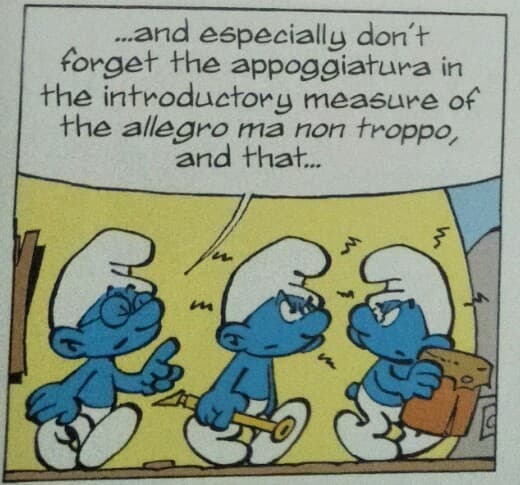
And then in 1967, we reach the Smurfette comic! When the smurfs grow tired of Smurfette, Brainy is shown to be a participant in the mean prank they all play on her. But once her appearance becomes modified, Brainy gets carried away just like all the other smurfs when it comes to fawning over Smurfette.

(I see those love hearts, Brainy. I SEE EM)
Not to mention the picture from the start of this post:

And funnily enough, at one point he’s so focused on Smurfette that he does not stop to listen to Papa Smurf!
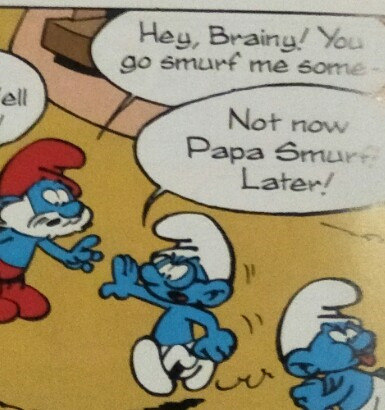
But when Smurfette’s ties to Gargamel are revealed, Papa Smurf designates Brainy as prosecutor in the trial of Smurfette! :D
There is something potentially to be said for that. It’s entirely possible that Brainy was only chosen at random to be the prosecutor because he simply happened to be standing nearby. Or perhaps Papa Smurf deemed him suitable for the role as well.
Whichever it is, Brainy indeed gets very into the role. He launches a staunch offense on Smurfette, and is pelted with produce in return. He also objects when a not-guilty verdict is reached. But he does look sad along with the others when Smurfette leaves the village.
Next we have 1967’s version of The Hunger of the Smurfs! We’ve already looked at the mini-story version in Part 1 of this post series; now we get the expanded-upon version. One difference is that this time we can be sure when Brainy is in a scene because he has his glasses now; and Peyo does have him present throughout the story, although the colour of his scarf is totally inconsistent, with him sporting a bunch of different-coloured ones throughout.
One item of note is this little bit here:

In the mini-story version, there’s no smurf saying “Don’t push!” in this bit. While situationally appropriate, it ties into his overall penchant for regulating others’ behaviour and purported mindfulness of the “what one should and should not do” in a situation. Yes, that’s a bit of a stretch to apply that here – it’s just one quick line in a panel – but it still ties into that theme when looked at in conjunction with everything else; a throughline.
In 1968 the expanded-upon version of The Smurfs and the Egg is published, which had originally been published in 1960. Just like with Schtroumpf Noirs, an originally Brainy-less story is updated to now include Brainy, featuring his presence for three panels at the start and then nothing further for the rest of the story.
The expanded-upon version of The Fake Smurf was published the same year, having originally been published in 1961. Again, nothing much of note development-wise for his character occurs, though this panel again reiterates his tendency to try and enforce behaviours for other smurfs, as well as enforcing the authority of Papa Smurf:
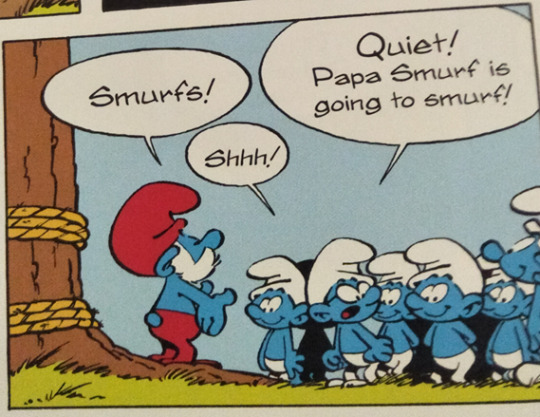
Next up we have the updated version of the Hundredth Smurf comic. Interestingly, despite being consistently called “smurf with glasses” in French ever since the name changeover, the updated version of Hundredth Smurf still refers to him as Schtroumpf Moralisateur. That singular panel in the Hundredth Smurf comic is the only early example I’m aware of where he gets labelled with that name! Otherwise, it’s typically Glasses Smurf. [Edit: @schtroumpfcurieux has since advised me that he’s also called “Schtroumpf Moralisateur” in 1971′s The Apprentice Smurf as well!]
1968 was also the original publishing date for the comic Smurf Traps. At the start, Brainy warns the others not to cheat at the hide-and-seek game they’re going to play, because cheating is bad.
Gargamel sets tailored traps for each of the smurfs, and what manages to first captivate and then capture Brainy is a very large book promising to be a lengthy Treatise on Morality, showcasing the character’s preoccupation with moral/proprietary rules.
Now it’s time for The Smurfs and the Howlibird, published 1969. Brainy’s character is very well-established at this point; there’s also a layer of irony present when he’s bossing the others around. In the Howlibird story, he’s so caught up in talking about how they should take aim at the Howlibird with “rapidity and precision” and urging the others to hurry it up that he’s ultimately delaying them, and is very particular about the placement of the stone, convinced that only he can fix it up the right way and that the others would be helpless without him.
Then there’s The Astrosmurf, from 1970…
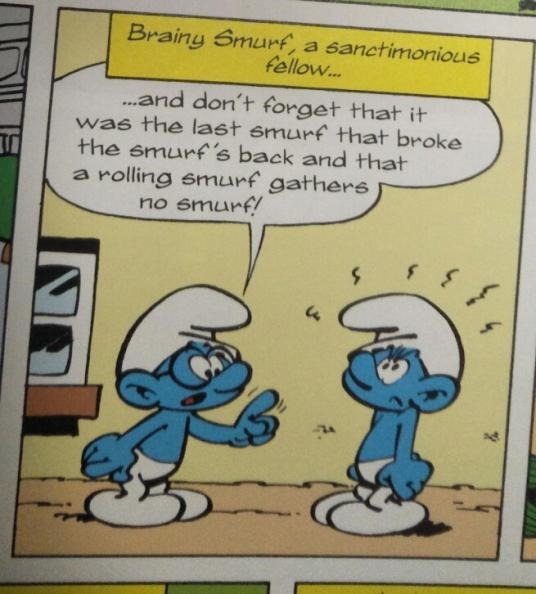
Yep. There’s that most encapsulating word that we keep circling back to: sanctimonious!
In the French panel, the word used is moralisateur, like from his original name;
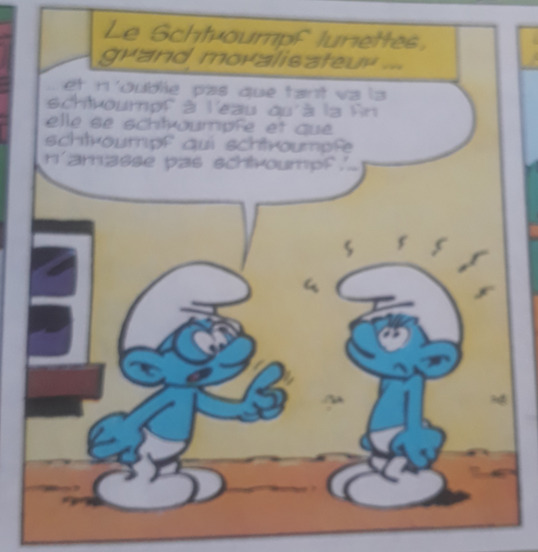
(Image courtesy of @schtroumpfcurieux)
Another thing that’s quite well-established at this point is that the other smurfs really aren’t big on Brainy. He’s generally a go-to target…

In The Weather-Smurfing Machine (published 1970), Brainy prudently brings along an umbrella, just in case.
And he also has this overdramatic little scene:

And just… gets up straight away, ahahah.
He’s someone inclined to insert himself and try to take charge of situations;
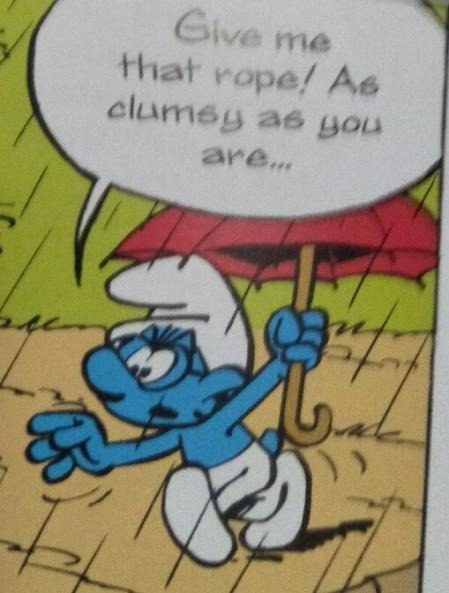
Brainy also follows/suggests following guidelines even illogically so or in a manner lacking common sense;
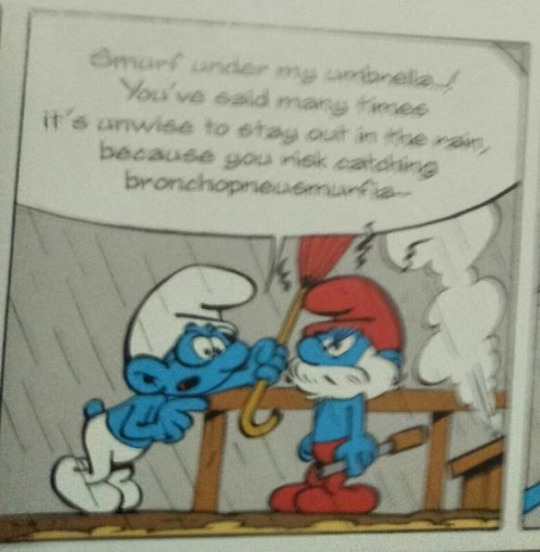
After all, that broken umbrella isn’t exactly going to do much against the rain. You could try adjusting the shape, but it’s pretty hard to do once they wind up like that.
When “The End” of the comic is announced Brainy rushes in to interrogate this supposed cut-off point as an ending. He declares that “a story must smurf a moral”! Well, they didn’t say he’s a moralisateur for nothing.

The effect of the speech bubble covering Papa really reinforces just how talkative he is.
In the one-page comic of “Master Smurf was Smurfing in a Tree”, part of the one-page comics published in 1971-1972, irony once again becomes involved: Brainy is so wrapped up in warning a smurf that they are sitting on the wrong side of a branch they are sawing off, and instructing them to be prudent, that he himself is now making the same mistake. In the other one-page comic “Careful, The Little Smurf Will Come Out”, when they’re all trying to get a photo taken together, he’s the only one who seems poised:

The comic “Be Smurf To Animals” from the one-page comic collection of 1972’s Histoires de Schtroumpfs seems to be among the first instances where he’s been casually depicted with book in hand, something that would become so iconic to the character:
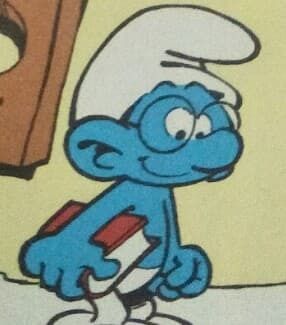
In 1973’s Smurf Versus Smurf comic, Brainy’s go-to to attempt to resolve the linguistic disputes is to consult his “grammar smurf”:

But… He doesn’t even seem to realise what he’s reading out since he starts going into totally irrelevant stuff:

Brainy continues consulting and reading from the book into the evening, even as a play is being put on for the smurfs. And when the rules of a smurfball game get modified, Brainy immediately intervenes to say Wait You Can’t Play Like That! He’s very much about rules and enforcing them. Rules, rules, rules!
Brainy’s blabbermouthing busybody behaviour escalates the situation before the comic’s end, as he informs both the Northerners and the Southerners of the others’ plan to hold a demonstration.
And I’ll leave this post off here for now! It may come across as a bit abrupt, but we have quite a bit happening on the horizon. In the next post, we’ll look at some more of the comics and then we also have the animated feature film first released in 1976, and then the smurfs franchise beginning to turn their eyes to other countries and looking at becoming more well-known globally... and what that means for Brainy’s character.
Thank you so much for reading! Looking forward to getting to Part 3 of this in the next post. The groundwork is quite solidly laid for the character now, so let’s see how it evolves going forward!
22 notes
·
View notes
Text
You can check out the 1960s animation featuring Brainy here
See also:
https://lostmediawiki.com/Les_Aventures_des_Schtroumpfs_%28partially_found_Belgian_animated_film;_1965%29
https://smurfs.fandom.com/wiki/Les_Aventures_des_Schtroumpfs
https://fr.m.wikipedia.org/wiki/Les_Schtroumpfs
Evolution of Brainy Smurf, Part 1: Where in the World is Brainy Smurf?
Years covered: 1959-1965
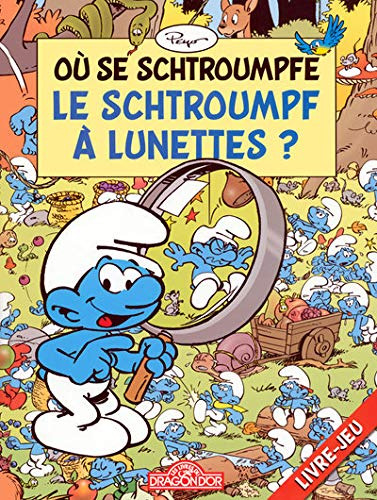
Hello, hello! I want to do a bit of an overview/analysis of the development of Brainy Smurf’s character throughout the years. This post will start at the very start of the timeline for Brainy Smurf canon, and go from there! Anyone can feel free to add on to this post. Expect more posts in the future as we go through the years!
[Disclaimer: I don’t understand French. I do understand Chinese. The latter is not particularly helpful for smurfs analysis. Huge thanks to @schtroumpfcurieux for all their help, who does know French.]
Pinpointing what could be considered the very first appearance of Brainy Smurf in print is not nearly as straightforward as one might think. The publishing order at the start here can get a little messy – self-proclaimed smurfologist Matt Murray says so himself in one of his write-ups within the Smurf Anthology books - so you’ll have to try and stay with me here.
We all know the smurfs originally appeared in comic form in Johan & Pirlouit, but that’s not when Brainy specifically first showed up. To try and locate our one and only dear Brainy Smurf, we must first turn our attention to the mini-récits or “mini stories” from when the smurfs started going solo, divorcing themselves from the human characters that gave them a leg-up into the comics world and forming a brand of their own.
Wikipedia lists Brainy’s first appearance in the comics as occurring in Les Schtroumpfs Noirs, which is not correct. Technically. Or, well… It’s complicated.
Keep reading
37 notes
·
View notes
Text
Evolution of Brainy Smurf, Part 1: Where in the World is Brainy Smurf?
Years covered: 1959-1965

Hello, hello! I want to do a bit of an overview/analysis of the development of Brainy Smurf’s character throughout the years. This post will start at the very start of the timeline for Brainy Smurf canon, and go from there! Anyone can feel free to add on to this post. Expect more posts in the future as we go through the years!
[Disclaimer: I don’t understand French. I do understand Chinese. The latter is not particularly helpful for smurfs analysis. Huge thanks to tumblr blog schtroumpfcurieux for all their help, who does know French.]
Pinpointing what could be considered the very first appearance of Brainy Smurf in print is not nearly as straightforward as one might think. The publishing order at the start here can get a little messy – self-proclaimed smurfologist Matt Murray says so himself in one of his write-ups within the Smurf Anthology books - so you’ll have to try and stay with me here.
We all know the smurfs originally appeared in comic form in Johan & Pirlouit, but that’s not when Brainy specifically first showed up. To try and locate our one and only dear Brainy Smurf, we must first turn our attention to the mini-récits or “mini stories” from when the smurfs started going solo, divorcing themselves from the human characters that gave them a leg-up into the comics world and forming a brand of their own.
Wikipedia lists Brainy’s first appearance in the comics as occurring in Les Schtroumpfs Noirs, which is not correct. Technically. Or, well… It’s complicated.
The mini-récits are, as the “mini” suggests, comics that are very small and condensed. These comics would later be revised by Peyo and redrawn in their entirety in a much bigger and expanded-upon format.
(French!) Wikipedia lists the mini-récits as follows, in order of publication date:
· Les Schtroumpfs noirs (1959)
· Le Voleur de Schtroumpfs (1959)
· L’Œuf et les Schtroumpfs (1960)
· Le Faux Schtroumpf (1961)
· La Faim des Schtroumpfs (1961)
· Le Centième Schtroumpf (1962)
There is no Brainy Smurf to be found anywhere in the 1959 version of Les Schtroumpfs noirs. We’ll circle back to this later and touch on it in more detail, I promise, but for now you just gotta bear with me as we continue our search for Brainy elsewhere. Onward!
What about next on the list, Le Voleur de Schtroumpfs from the same year? (AKA: “The Smurfnapper”).
Would you believe me if I said that originally, Brainy Smurf did not have glasses? Yes, despite his French name literally being “Smurf with glasses”. Because before he was known as Schtroumpf à lunettes, he was Schtroumpf Moralisateur.
So, without glasses as an obvious visual cue, one of the main ways to identify if a smurf is Brainy or not is by his personality… So let’s take a look at Le Voleur de Schtroumpfs.

Here, my friends, is what I have personally pinpointed as the very first appearance of the Schtroumpf Moralisateur, as the smurf in front holding the bag. He already has his trademark admonishing raised finger!
In the redrawn, expanded-upon version of Le Voleur de Schtroumpfs published some years later in 1963, this smurf is indeed confirmed to be Brainy:
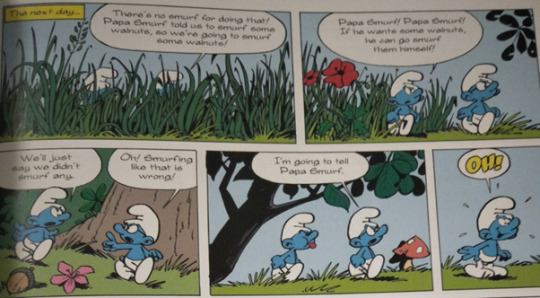

Here, the smurf who would be Brainy emerges for the first time in smurf canon out from behind the grass, establishing himself upfront as a character who wants to go by the book, insisting they do as they’re told and admonishing his fellow smurf for considering otherwise.
I love how in the redrawn version from a few years later, Peyo makes a point of making his expression less neutral in this same panel, hahaha:

When the other smurf gets captured, he admonishes them for their behaviour.
Then, at the end of the comic, Brainy Smurf-Without-Glasses pulls an “I told you so!” and finishes with one of his trademark holier-than-thou rants:

In the vein of “If only you’d listened to Papa Smurf / You must listen to Papa Smurf…”
And there you have it: there’s a very solid case to be made that this is Brainy’s first appearance. A smurf that is unafraid to unrelentingly lecture others on what they should and should not do. A sanctimonious moralisateur.
The next mini-story pinpointed as featuring Brainy is La Faim des Schtroumpfs or “The Hunger of the Smurfs / The Hungry Smurfs”, published in 1961.

We can tell this smurf in this comic is Brainy due to not only the speech/style/mannerisms, but also because just like with the previous story we looked at, this smurf is redrawn as Brainy with his glasses in the expanded-upon version.
Showing up and getting all “Papa Smurf says we should do X therefore we need to do X…” makes it easy to connect this smurf as being the same one from The Smurfnapper that we just looked at, and it’s easy to conclude that Peyo had the same smurf in mind when he made this comic as well.
After he shows up and has that one piece of Brainyesque dialogue, there’s not really anything of note Brainywise for the rest of the comic. We can safely assume he’s presumably there among the other smurfs, but with the only way to distinguish him in these mini-stories being when his personality is shown, there’s no smurf among the group designated by Peyo for us to know for certain is Brainy for the remainder of the comic.
Next, we have Le Centième Schtroumpf - the Hundredth Smurf mini-story comic published in 1962, the final mini-story of this fashion featuring our dear Brainy, and for the very first time, he gets a name! How exciting! Well, I think it is, at least.

There! Now named Schtroumpf Moralisateur, he’s telling off Schtroumpf Gourmand for gluttony.
Nothing of note Brainywise for the rest of the comic, but the name itself really sums up Peyo’s thoughts and approach here when writing Brainy into the comics: he’s preoccupied with judging and lecturing sanctimoniously to others about their actions/behaviour.
We now reach 1963, when the expanded version of Les Schtroumpfs noirs (or “The Purple Smurfs” in English) was published, and we can finally circle back to that kinda-tangent I put aside at the very start.
Brainy, it’s time for you to don your glasses!

There you are, Brainy.
Brainy is the smurf who goes off and encounters the first smurf afflicted by the Bzz Fly, quickly rushing back and warning Papa Smurf.
But wait – in the original mini-story version of 1959, the smurf who does this is just some random smurf with no defining characteristics. Although you could try and make some technicality argument that this retroactively makes the smurf who took this role originally Brainy too, I approach this moreso from the view of artist intent. When Peyo was working on the 1959 version, I sincerely doubt he had Schtroumpf Moralisateur in mind for that random smurf. But for some reason, when he expanded on the comic in 1963, he decided to make this smurf Brainy now. It’s interesting, because there’s no real reason for the smurf to be Brainy – it could just as easily have been any other smurf – but he added those glasses in.
Published alongside the new-and-improved Schtroumpfs Noirs story in 1963 is “The Flying Smurf” (Le Schtroumpf Volant).
Our new glassesified Brainy is in this story from the very first panel! This is the first brand-new story featuring a glasses-clad Brainy, and unlike with Schtroumpfs Noirs his personality readily shows through. Papa Smurf sends Brainy and another smurf into the forest to get walnuts, the other smurf gets distracted by an apple which he goes after…

Back at it once more with the lecturing, the admonishing, and the insistence that they strictly stick to their given instructions.
Also, he abruptly starts singing at the top of his lungs, as you do.

The other trait established about Brainy is that he’s the tattle-tale “I’ll tell on you!” type as well.
Despite haphazardly following his fellow smurf around for the majority of the comic insisting on the walnuts, he never does get around to actually getting them for Papa Smurf. He was too busy pestering his fellow smurf about it instead.
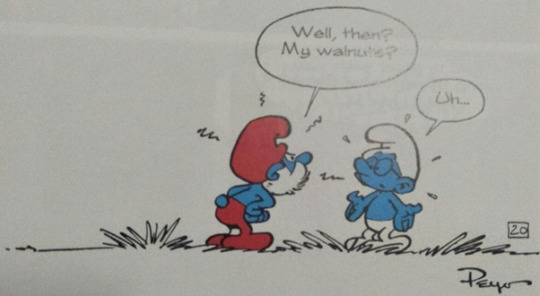
Even when the plot of the comic carries over to the next day, Brainy’s still trying to chase this smurf and insist on it, and then he’s confronted like this in the comic’s final illustration.
1963 also brought us the expanded-upon version of Le Voleur de Schtroumpfs (The Smurfnapper). We’ve already covered the mini-story version so let’s just have a look at any notable changes in this expanded version, other than the fact that Brainy now has his glasses.
We have another instance of the updated comic depicting Brainy with a crankier expression than he had originally for the same panel:

That’s the main change of note that I can see.
Also, around this time, some of the comics were adapted into an animated TV series. You can read more about that in the “The Smurfs (1961 TV series)” article on the smurfs fandom wiki, and also on the Les Aventures des Schtroumpfs page on the Lost Media wiki. One of the stories adapted into animation was The Smurfnapper! Much of the footage from the 1960s series is considered lost media, but some of it survives. Some of that surviving footage shows Brainy’s presence in the adapted Smurfnapper story!
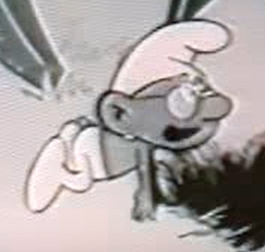

I’ll link the footage in a reblog, along with other relevant links.
Brainy’s voice has a very high pitch within this animation, likely chosen to be this way due to his very small size. He’s shown lecturing his fellow smurf as he does in the comic it’s an adaption of, and the smurf is shown plugging his ears in response:

(Because that’s another thing the comics have established by this point: the smurfs looking annoyed when being lectured to or not being interested in hearing what Brainy has to say).
But this voice doesn’t have that certain layer of intentional over-the-top emphasis that Danny Goldman’s performance would later bring to the character in the 80s. Here, the voice sounds more cute than anything, and the lecturing sounds more matter-of-fact and neutral than Danny Goldman would play it as.
And whew, now we’ve reached the King Smurf comic, published in 1965. This is a big one for Brainy.
Papa Smurf leaves the village temporarily and unlike the other smurfs, Brainy is not interested in slacking off or playing games. He’s all business.
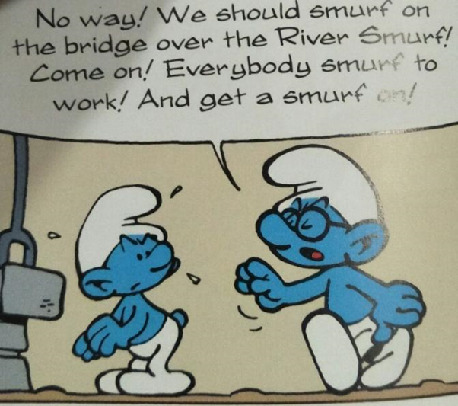
The other smurfs aren’t interested in listening to him at all, and then Brainy makes this assertion:
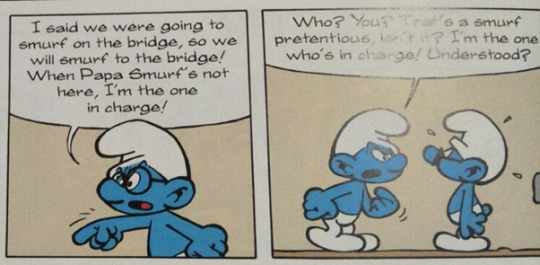
Bossy, bossy! His claim continues to be met with pushback from the others who begin declaring individually that, no, they will be the ones in charge. We have not seen any indication that Papa Smurf has actually granted Brainy any sort of authority. This, coupled with the reaction of the other smurfs and their immediate attempts to make the same claims/assertion of authority on no basis suggests that Brainy was likely making this claim to authority from absolutely nowhere, simply trying to forcefully assume the position of leadership and unsuccessfully trying to get the other smurfs to simply stand down and accept it.
And here, it seems we may have the very first instance of the Brainy-getting-hit gag:
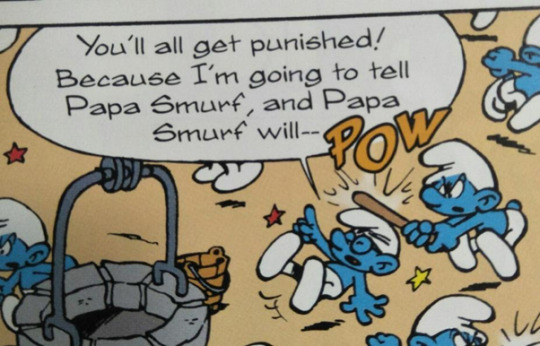
Though it’s introduced in the midst of all the smurfs fighting and harming each other.
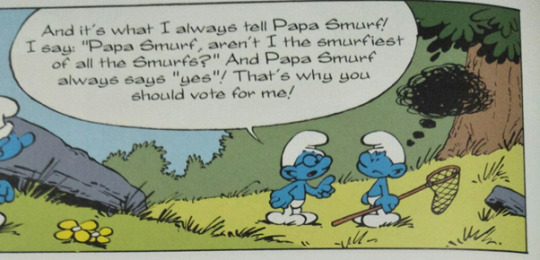
You know, I somehow doubt that Papa Smurf would say that and play favourites with his little smurfs :P Sounds like you’re saying whatever and talking gobbledegook in a bid to get elected or you’ve misunderstood Papa, Brainy. He then gets referred to as a “bore” by the others.

Mallet joke kicking into gear XD
Also, Brainy gets christened as Schtroumpf à lunettes for the first time! Peyo’s decided to go with that name instead of the Moralisateur one now that he has glasses.
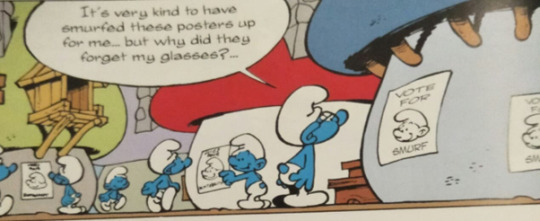
Oh Brainy. Brainy, Brainy, Brainy… So wrapped up in himself and self-assured in his assumption the others would want to vote for him. Not being the brightest bulb here. I love this gag XD. Totally delusional.

Oh, and he tries to commit voter fraud too. The so-called formerly-named Moralisateur is not above hypocritically bending the rules to benefit himself, it seems.
And once the other guy is elected…

Brainy Smurf, shameless suck-up, everyone. A real sycophant.
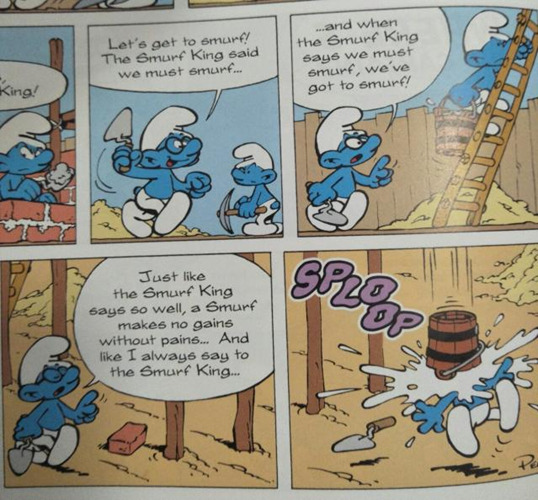
Ok bootlicker.
His words of “And like I always say to the Smurf King…” are presumably as empty as his claims that Papa says he’s the smurfiest. The total 180 turn that Brainy pulls here in very sudden supposed support of the smurf he was openly opposing just before (but of course, now that smurf has power, which makes a difference, y’see) reveals a serious lack of actual sincerity and conviction to his character. He talks a big game and makes a big show of a lot of things. But this suggests that much of it is merely empty words and empty gestures. It even calls into question just how sincere his support of Papa Smurf actually is, given how similar his words here are compared to when he’s talking about Papa Smurf. At the end of the day… Papa Smurf holds the power as the leader. And this comic tells us that Brainy’s sycophantic as hell.
Not to mention this line Brainy has earlier in the comic, before Smurf is elected, trying to deter the other smurfs from voting Smurf in:
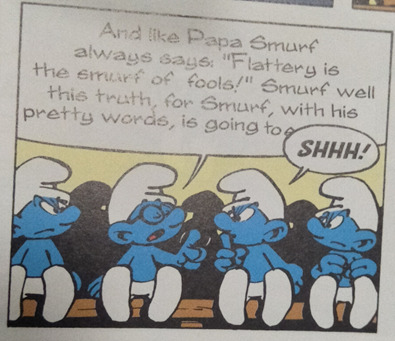
He claims “Flattery is the smurf of fools”, but he absolutely won’t hesitate to stoop to it himself. Because he’s a hypocrite. You could argue it suggests he may not actually care about, believe, or really pay attention to the very words he speaks.
“Long live the smurf king!”, he declares.
But he finds Jokey’s imprisonment to be wrong, and tries to convince King Smurf on this matter - because he does not abide by his fellow smurf’s wrongful imprisonment.
But King Smurf refuses Brainy’s advice about imprisoning Jokey being a bad idea, so he joins up with the anti-King Smurf league. In secrecy, mind you.
He gets caught and jailed, and eagerly awaits the glory and praise for heroism that will come with his surely speedy rescue. And waits. And waits. Finally, he manages to get out of prison... eventually, towards the end. And there we have the King Smurf comic.
That’s really skipping over what happens as opposed to going into more depth, but my aim here is to not so much do plot summaries as it is to try and pinpoint moments of note when it comes to Brainy’s characterisation over the years.
I’ll end off the first part of this post series here for now, though I have far more written up ready to go - we’ll pick up next time, still in the year 1965, with The Smurfony comic. :) Thanks for reading!
37 notes
·
View notes